

|

Ben Wong spends a good number of his waking hours fishing, preparing fish and talking about fish, yet he readily admits that he can't get a lot of people to confront a fish with fins and skins attached. Not for dinner, anyway.
'Hawaii goes fishing'
Host: Ben Wong
Air times: Each new show debuts at 5 p.m. Sunday and repeats frequently through the week Channel: OC16 Web site: www.hawaiigoesfishing.com
|
But no sense swimming against the tide, so to speak. Wong, host of the OC16 show "Hawaii Goes Fishing," is an expert fish-fillet-er, and put together a how-to lesson for a show that debuts Sunday.
He chose papio for his demonstration because it is the fish most likely to be brought home by a local fisherman. It was about 1 1/2 pounds -- about 14 inches long from tail to nose -- a size he recommends as big enough to fillet, but still small enough to cook quickly.
Papio is actually better filleted than whole, he said, because it will cook more evenly and turn out more tender.
Wong can fillet in a matter of seconds, but we forced him into stop-motion for our camera. To see it in real time, tune in Sunday.
Fish-cutting 101
To begin, your fish should have clear eyes, flesh that bounces back when pressed and a clean scent. An unpleasantly fishy smell is the scent of blood and indicates excessive hemorrhaging when the fish was caught. Using Ben Wong's technique, you do not have to scale the fish or remove the organs.

![]()
1. Insert the tip of the knife behind the pectoral fin and cut into the head, following the back muscle. Don't cut through the vertebra or puncture the organs.

![]()
2. Snap the head to break the vertebra, then firmly pull. If you did everything right, the organs should follow. Wong insists this is not hard, even for the beginner.

![]()
3. Cut through the fish's back, holding the knife flat, following closely along the skeletal structure, until you hit the center bone.
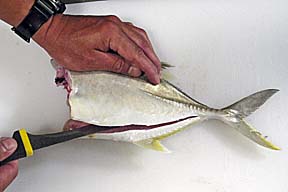
![]()
4. Make another cut in the belly, again cutting toward the center bone. Turn the fish over and repeat Steps 3 and 4.
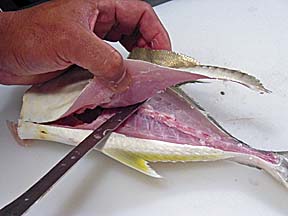
![]()
5. Beginning from the tail, lift the flesh flap and make short cuts along the center bone. Use the tip of the knife to cut through the tiny pin bones.
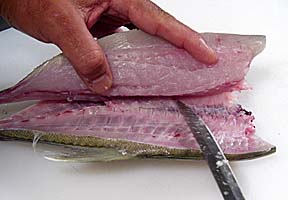
![]()
6. Separate the two fillets, using the knife tip to cut away the flesh. These two steps will require the most practice, Wong says.
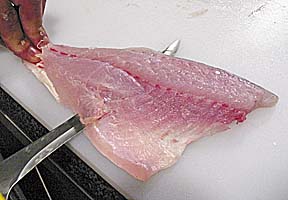
![]()
7. To skin the fillet, work at the edge of the counter, holding the knife flat. Use a sawing motion and cut as close to the skin as possible.
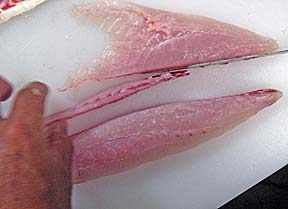
![]()
8. Separate each fillet into two smaller pieces, removing the blood line and the pin bones that run through the center.

Click for online
calendars and events.